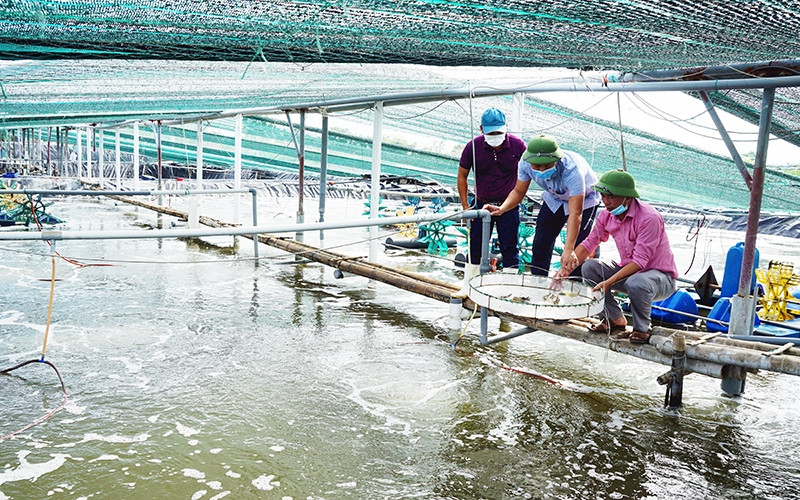Efforts to promote aquaculture and overcome the COVID-19 pandemic
Do Quang Bon, residing in Bach Dang hamlet, Thai Thuong commune, Thai Thuy district, Thai Binh province, is the owner of the largest white leg shrimp farming facility in Thai Thuong commune. Despite being affected by the pandemic, his family still harvests more than 100 tonnes of commercial shrimp, earning 8 - 9 billion VND (396,000 USD) per year.
Many other households in Thai Thuy and Tien Hai districts (Thai Binh province) have also made efforts to respond to the pandemic by applying advanced technology to maintain shrimp farming year round, earning stable income. They also utilise the advantages of wide tidal flats and abundant natural food to expand the scale of clam breeding with a total area accounting for 36.5% of the total aquaculture area in Thai Binh province.
Thai Binh has always maintained stable aquaculture production with about 110,000 tonnes of saltwater clams per year and 12,000 tonnes of brackish water clams per year. The average value of clam farming is about 300 million to 400 million VND per ha, which becomes the main product of Thai Binh province.
The coastal mudflat region in Ninh Binh province has an area of more than 7,000 ha which moves to the sea about 100 m every year. Local farmers in Ninh Binh province have established more than 300 farms which produce breeding oysters and clams with a value of 1.5 - 2 billion VND per ha per year.
Despite the raging COVID-19 pandemic, farmers in 19 coastal communes and towns encompassing Hai Hau, Giao Thuy and Nghia Hung districts (Nam Dinh province) are still actively boosting the marine economy. Nam Dinh province expects that the production value of coastal areas will account for 30% to 35% of the total production value by 2025 and will become a strong economic growth driver of the province by 2030. Nam Dinh has also focused on building more than 50 intensive aquaculture areas according to VietGAP standards to fulfil its goal.
The first container of canned clam meat was exported to Europe on November 22 by Lenger Seafoods Vietnam Company Limited based in Nam Dinh, opening a great opportunity for the province to promote its seafood consumption worldwide.
“The marine economy has become an important driving force for Nam Dinh socio-economic development, with an annual contribution of over 25% to the total production value of the province,” said Chairman of Nam Dinh provincial People's Committee Pham Dinh Nghi.
Looking towards green growth

Drying fish at a residential area in Diem Dien town, Thai Thuy district, Thai Binh province
Director of the Department of Agriculture and Rural Development of Thai Binh province Dinh Vinh Thuy said the province aims to strengthen the application of science and technology in aquaculture and seafood production under value chains to meet domestic consumption and export.
The province has conducted many projects to protect and promote aquatic resources and attract investment through the building of coastal roads and upgrading seaports and fishing ports. Thai Binh has maintained an average catch of about 80,000 tonnes of seafood per year.
Nam Dinh province has also focused on building a master plan for socio-economic development to 2030, with a vision to 2045, including a strategy for marine economic development.
The Ninh Co economic zone, with a scale of nearly 14,000 ha, was added to the master plan on the development of coastal economic zones in Vietnam. Industrial clusters with a total area of more than 500 ha were also included in the development planning of coastal areas.
However, experts say that the development of a marine economy in the provinces of Thai Binh, Nam Dinh and Ninh Binh is not really commensurate with the potential and advantages. The scale of aquatic farming and processing is small and lacks linkage which is yet to create a breakthrough to accelerate the economic restructuring.
The proportion of marine economy has increased, but at a low pace, while industrial production, especially the seafood processing industry and sea related commercial activities remain modest. In addition, technical infrastructure systems in the coastal areas are not synchronous and fail to meet the requirements of marine economic development.
Provinces in the region should invest in building deep-water seaports and shipping services to boost offshore fishing activities while limiting the exploitation of near-shore aquatic resources and strictly handle destructive fishing.
They also need to speed up the construction of coastal roads in order to connect localities in the region, serving the circulation and trade of goods and products, especially marine products. It is also necessary to form processing industrial parks, coastal economic zones and urban centres. In addition, these provinces should strengthen the control of wastewater sources from aquaculture activities to move towards green growth and improve the lives of people in coastal areas.
















